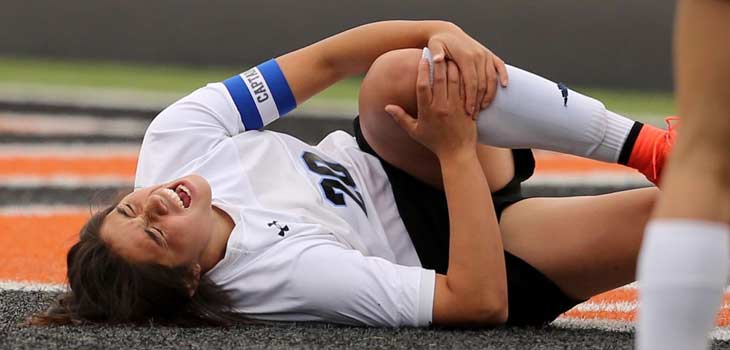
The ACL (anterior cruciate ligament) is one of the main structures in the knee that prevents instability or forward movement of the tibia on the femur. Like any ligament, the ACL can be sprained or ruptured but due to the way injury occurs a rupture is more likely. The ACL is typically injured in sports that involve high-impact movements, jumping and cutting activities. These include football, netball, AFL and hockey.
How do I know if I have injured my ACL?
The ACL is typically injured in non-contact movements such as pivoting on the knee in a loaded position although it is also possible to rupture through contact injuries such as a blow to the leg or knee.
It is common to hear or feel a ‘pop’ sensation and the knee will likely swell over the next few hours. You may have difficulty walking straight away and feel a sensation of instability when putting weight through the knee. It is not uncommon to be able to walk or even jog in straight lines after ACL injury as the ligament is under more stress in preventing pivoting-type motions.
Your physiotherapist will usually be able to diagnose an ACL rupture with hands-on testing but confirmation through MRI will determine if there are any other structures such as the MCL or meniscus that are also damaged.
What to do next?
The first thing to do is to allow the swelling to reduce and restore normal walking. Ice and compression can be beneficial in helping this to occur and you may require crutches to help achieve a more comfortable walking pattern as early weight-bearing is encouraged to promote recovery.
The next step should be to consult with your physiotherapist regarding a plan of management. This should involve beginning the rehabilitation process to return to your given sport or activity and this may involve referral to an orthopaedic specialist.
Early movement and activation of the quadriceps muscles are vital in returning to normal function as soon as possible and rehabilitation should begin prior to any surgical intervention in most cases.
Treatment options?
ACL ruptures can be managed either surgically or non-surgically (conservatively) and will depend on a number of factors. Some of these include injury to other structures, stability of the knee joint post injury, the type and level of sport you play and the response to pre-habilitation.
We know that post-operative outcomes are better if the knee has restored movement along with minimal swelling and adequate strength and therefore physiotherapy for 1-3 months prior to surgery is beneficial
A non-surgical approach should employ a similar approach to restoring range of movement, pain and swelling.
Rehabilitation
The rehabilitation process after ACL surgery typically occurs over a 9-12 month period and should start soon after surgery and progressions through rehab stages should be assessed individually. Initially, this involves restoring movement, activating and re-strengthening the quadricep muscles and reducing post-op swelling and pain. The next phase will involve more complex strengthening exercises of the glutes, hamstring, quads and calf along with balance and proprioception exercises. You may begin running around the 3-month mark and return to sport can occur from 9 months onwards but will depend on factors such as age, type and level of sport and type of injury. Evidence shows that every month that return to sport is delayed from 6 to 9 months – re-injury risk is halved.
A non-operative approach should be similar in terms of rehabilitation and should aim to restore movement, strength and stability before progressing to more functional activities and then running. This should ideally be supervised by your physiotherapist to allow for best outcomes and reduced rates of re-injury. Return to sport is possible post-conservative management and should be discussed with your physiotherapist.
Every rehabilitation process is different and should be a combined effort between yourself, your physiotherapist and your specialist.
Is there any way to prevent an ACL injury?
It is possible to reduce your chance of injury via specific strengthening and proprioception exercises along with pre-activity warm-up protocols.
Some of these can be found on your sporting associations’ webpage.
Netball Australia: Netball Knee Program
Football NSW: FIFA 11+ program
 Helping the Central Coast Feel Well, Move Well and Perform Well!
Helping the Central Coast Feel Well, Move Well and Perform Well!